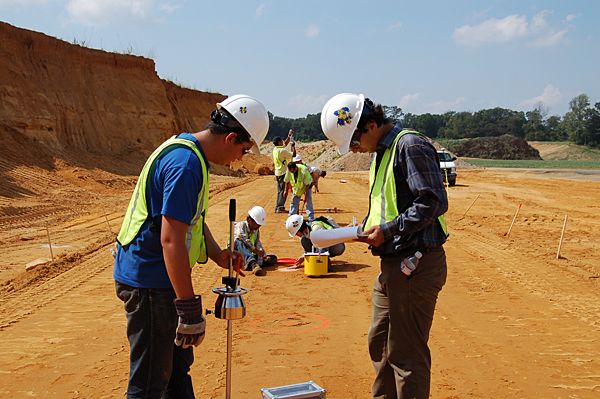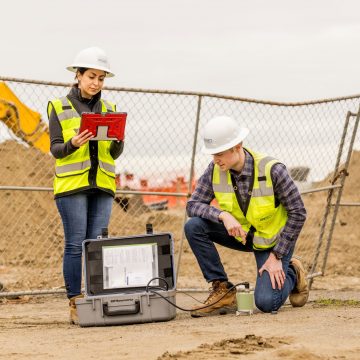Why Employing a Geo Tech Engineer is Critical for Facility Building And Construction Tasks
Why Employing a Geo Tech Engineer is Critical for Facility Building And Construction Tasks
Blog Article
The Significance of Dirt Analysis and Site Examination in the Geotechnical Market: Ensuring Safety And Security and Stability in Civil Engineering
In the geotechnical market, soil evaluation and site examination are fundamental aspects that underpin the safety and security and security of civil design projects. By thoroughly comprehending dirt homes, designers can preemptively attend to prospective obstacles, ultimately safeguarding structural honesty.
Recognizing Dirt Residences
In the realm of geotechnical engineering, a thorough understanding of dirt residential or commercial properties is extremely important for informed decision-making and efficient project style. The characterization of soil includes the exam of numerous physical and mechanical homes, such as grain size distribution, plasticity, permeability, shear, and communication stamina. These homes dictate how dirt behaves under different loading problems and ecological impacts, making them essential for assessing site viability for construction projects.
Dirt classification systems, such as the Unified Soil Classification System (USCS) and the AASHTO category, give frameworks for grouping soils based on their characteristics. This classification help engineers in forecasting actions under anxiety, water flow, and settlement, consequently affecting layout choices and building and construction strategies.
Moreover, the interaction between soil and surrounding frameworks is a key factor to consider in geotechnical design. Recognizing soil homes assists recognize prospective difficulties, such as liquefaction in earthquake-prone areas or excessive negotiation in soft dirts. By completely examining these residential properties, geotechnical designers can make certain the safety and security, stability, and long life of structures, inevitably adding to the total resilience of civil design jobs.
Methods of Dirt Analysis

In-situ tests include techniques such as Basic Penetration Examinations (SPT), Cone Penetration Tests (CPT), and vane shear tests. SPT evaluates the resistance of dirt to infiltration, offering data on thickness and strength, while CPT measures soil resistance and pore stress, generating constant accounts of dirt stratigraphy. Vane shear tests are especially valuable for analyzing the shear stamina of cohesive dirts.
Laboratory examinations match these in-situ analyses and include sampling dirt for regulated testing. Usual research laboratory methods consist of Atterberg limitations, which determine the plasticity characteristics of fine-grained dirts, and compaction tests, which examine moisture-density connections. Added examinations, such as triaxial compression and unconfined compression examinations, are conducted to review the shear stamina of dirt examples under numerous conditions.
Function of Website Examination
Website examination plays a critical duty in the geotechnical design procedure, acting as the structure for understanding subsurface problems. This extensive evaluation includes systematic expedition of dirt and rock properties, groundwater levels, and various other geological functions that influence project safety and security.
Commonly, site examinations incorporate a variety of strategies, consisting of boring boreholes, sampling, and in-situ testing. These methods provide critical information on the mechanical and physical features of the ground, notifying engineers concerning potential difficulties such as soil settlement, birthing ability, and slope security.
Moreover, site investigation our website facilitates the recognition of dangerous products and impurities, making it possible for the application of suitable remediation steps. By developing a precise subsurface profile, website examinations help to mitigate dangers related to building, ensuring that projects follow security criteria and regulations.
The findings from a thorough website examination not just overview style decisions yet also affect building and construction techniques and timelines. In summary, the significance of site examination can not be overstated; it is an important action in the geotechnical design procedure, laying the groundwork for effective task implementation while prioritizing public security and ecological integrity.
Effect on Task Layout
A comprehensive understanding of soil features substantially influences job design in the geotechnical market. Soil evaluation educates designers regarding the mechanical properties, make-up, and habits of the ground, which are vital aspects in determining the usefulness and security of a construction project. Accurate information on dirt compressibility, strength, and leaks in the structure allow for the development of effective structure designs, making certain that structures are sufficiently sustained and secure throughout their lifespan.
Additionally, the visibility of pollutants or unstable soil layers can motivate adjustments in task design, such as choosing alternative building techniques or materials. This aggressive technique lessens risks associated with soil negotiation, extreme loading, or side movement, therefore protecting both the honesty of the framework and public security.
The combination of dirt evaluation right into task design additionally assists in conformity with regulative requirements and ecological factors to consider. By attending to soil-related challenges early in the style process, engineers can maximize resource allocation and reduce possible delays and expenses related to unforeseen website conditions. Ultimately, comprehensive soil analysis improves the general high quality and longevity of civil engineering jobs, causing more resilient and sustainable infrastructure.
Study and Examples
Showing the vital role of soil analysis in the geotechnical market, numerous study highlight its effect on task end results. One noteworthy example is the building of a skyscraper building in midtown Los Angeles, where considerable dirt testing revealed unpredictable subsurface problems. tailings engineer. By determining the visibility of extensive clay, engineers had the ability to redesign the foundation, integrating deep pilings that made certain security and safety, eventually protecting against possible structural failings

Lastly, a dam project in the Southeast faced hold-ups due to unanticipated dirt erosion concerns. In-depth dirt analysis enabled designers to carry out reliable stablizing strategies, ensuring that the dam satisfied safety and security guidelines while sticking to the job timeline. These situations highlight the requirement of thorough dirt analysis and website examination, highlighting their vital he has a good point role in attaining effective and risk-free civil design jobs.
Verdict
Finally, soil analysis and website examination are essential components of the geotechnical industry, playing a vital function in making sure the security and stability of civil engineering tasks. By offering important information on dirt residential properties and subsurface conditions, these processes notify structure style and building and construction methodologies. Furthermore, comprehensive examinations add to danger identification and risk reduction, ultimately boosting the long life and resilience of structures while enhancing resource appropriation throughout the project lifecycle.
In the geotechnical industry, dirt evaluation and site investigation are foundational aspects that underpin the security and stability of civil design projects. Comprehending soil residential properties assists identify possible challenges, such as liquefaction in earthquake-prone locations or too much settlement in soft dirts. SPT examines the resistance of dirt to penetration, supplying information on thickness and strength, while CPT gauges soil resistance and pore stress, producing continual accounts of dirt stratigraphy. These situations underscore the requirement of extensive dirt analysis and website investigation, highlighting their essential duty in achieving risk-free and effective civil engineering tasks.
In final thought, soil evaluation and website examination are fundamental parts of the geotechnical industry, playing an essential role in guaranteeing the safety and security of civil design tasks.
Report this page